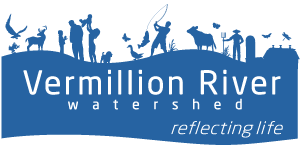Who We Are
Do you live in the Vermillion River Watershed?
Check our interactive map!
The Vermillion River Watershed is the largest watershed in the Minneapolis-St. Paul seven-county metropolitan area. The watershed drains 335 square miles in Dakota, Goodhue, and Scott counties. (What is a watershed?) It provides many opportunities for people to get involved in its care, learn about the environment and the ecosystems, and enjoy recreation just a few miles from downtown Minneapolis and St. Paul.
The Vermillion River got its name from the red and orange ochre found in nearby sandstone and rock seams. The local indigenous Dakota people call it Wa Se Sa Wa Kpa, meaning Red Paint River. The color vermilion is a rich shade of red-orange. (Be careful not to confuse this Vermillion River, with two L’s, with the Vermilion River with one L in northern Minnesota, connected to Lake Vermilion.)
The river emerges in New Market Township, Scott County, and meets the Mississippi River near Red Wing. The Vermillion River main stem travels 35 miles west to east, joined by four major tributaries (North Creek, Middle Creek, South Creek, and South Branch) and many unnamed minor tributaries. The watershed includes 49 miles of Minnesota Department of Natural Resources-designated trout streams and eight recreational lakes.
The watershed encompasses farmland, suburban residential areas, business districts, industrial zones, parks, and open spaces. Cities and townships including Apple Valley, Burnsville, Castle Rock Township, Coates, Douglas Township, Elko New Market, Empire, Eureka Township, Farmington, Hampton, Hampton Township, Hastings, Lakeville, Marshan Township, New Market Township, Nininger Township, Ravenna Township, Rosemount, Vermillion, and Vermillion Township make up the watershed. In 2002, Dakota and Scott counties signed a joint powers agreement to form the Vermillion River Watershed Joint Powers Organization (VRWJPO) and manage the watershed as required by Minnesota Statutes 103B and Minnesota Rules 8410.
Today at the VRWJPO, we partner with communities to invest in watershed improvement. We conduct extensive monitoring to analyze water quality and quantity. We implement our Watershed Plan by putting projects in the ground that protect and enhance water resources. We set Standards and help local governments meet them. We inform, educate, and engage people in environmental stewardship. Taking care of the resource today ensures that the river will continue to provide clean water, habitat for fish and wildlife, and a high quality of life for our people.


